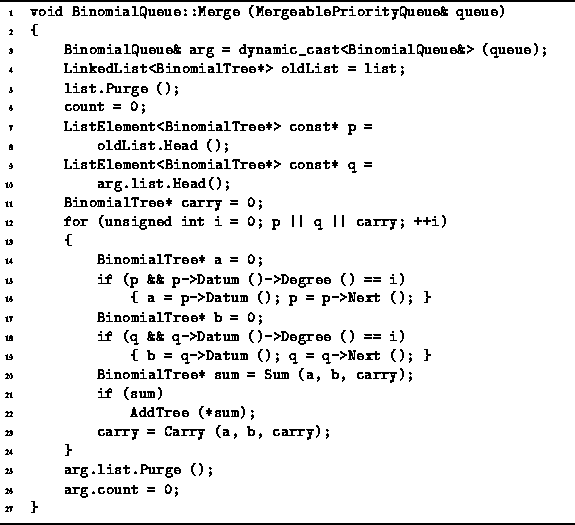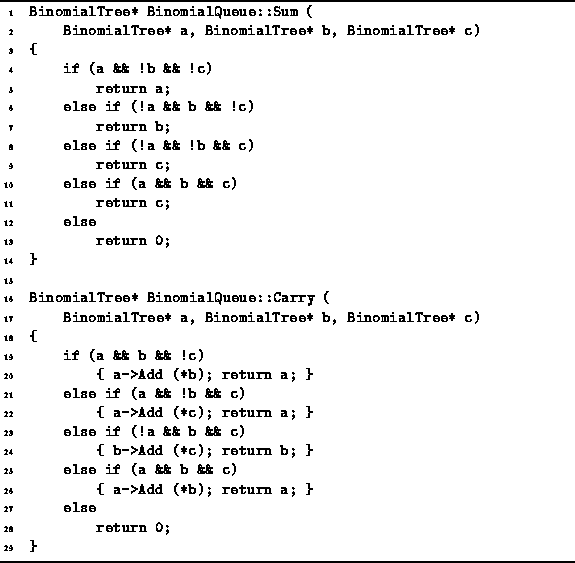Merging two binomial queues is like doing binary addition.
For example, consider the addition of ![]() and
and ![]() :
:
| | | | | | | ||
| + | | | | | | ||
|
| | | | | | | |
In the next step,
we add the ![]() from
from ![]() and the
and the ![]() from
from ![]() .
Combining the two
.
Combining the two ![]() s we get a
s we get a ![]() which we carry
to the next column.
Since there are no
which we carry
to the next column.
Since there are no ![]() s left,
the result does not contain any.
The addition continues in a similar manner
until all the columns have been added up.
s left,
the result does not contain any.
The addition continues in a similar manner
until all the columns have been added up.
Program ![]() gives an implementation of this addition algorithm.
The Merge member function of the BinomialQueue class
takes a reference to a BinomialQueue and adds its subtrees
to this binomial queue.
gives an implementation of this addition algorithm.
The Merge member function of the BinomialQueue class
takes a reference to a BinomialQueue and adds its subtrees
to this binomial queue.

Program: BinomialQueue Class Merge Member Function Definition
Each iteration of the main loop of the algorithm (lines 12-24)
computes the ![]() ``bit'' of the result--the
``bit'' of the result--the ![]() bit is a binomial tree of order i.
At most three terms need to be considered:
the carry from the preceding iteration and two
bit is a binomial tree of order i.
At most three terms need to be considered:
the carry from the preceding iteration and two ![]() s, one from each of the queues that are being merged.
s, one from each of the queues that are being merged.
Two functions, Sum and Carry,
compute the result required in each iteration.
Program ![]() defines both Sum and Carry.
Notice that the Sum function simply
selects and returns one of its arguments.
Therefore, the running time for Sum is clearly O(1).
defines both Sum and Carry.
Notice that the Sum function simply
selects and returns one of its arguments.
Therefore, the running time for Sum is clearly O(1).

Program: BinomialQueue Class Sum and Carry Member Function Definitions
In the worst case, the Carry function calls the Add function to combine two BinomialTrees into one. Therefore, the worst-case running time for Carry is
![]()
Suppose the Merge routine of Program ![]() is
used to combine a binomial queue with n items with another
that contains m items.
Since the resulting priority queue contains n+m items,
there are at most
is
used to combine a binomial queue with n items with another
that contains m items.
Since the resulting priority queue contains n+m items,
there are at most ![]() binomial trees in the result.
Thus, the running time for the Merge operation is
binomial trees in the result.
Thus, the running time for the Merge operation is
![]()